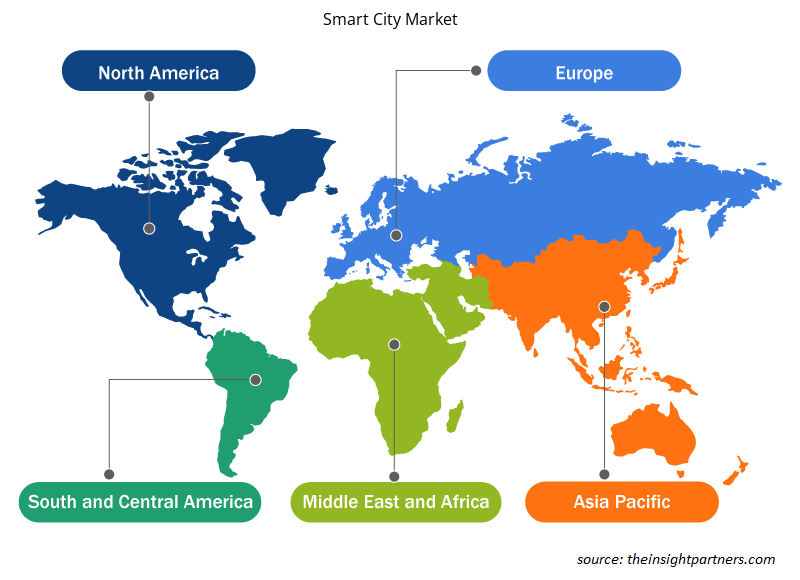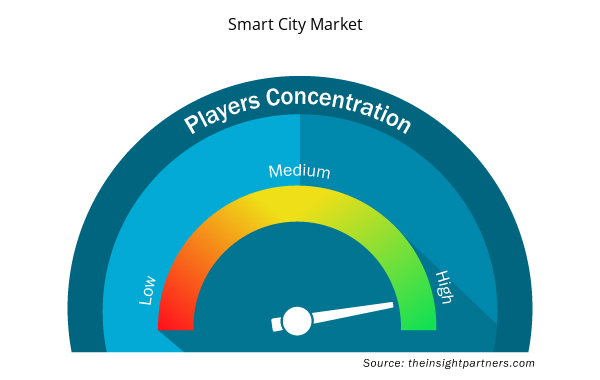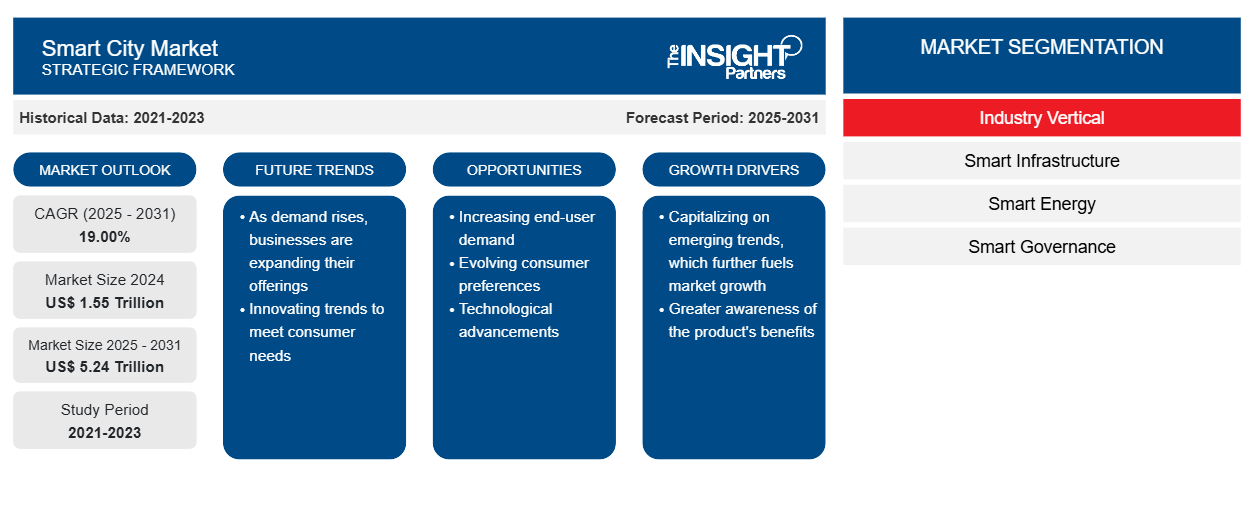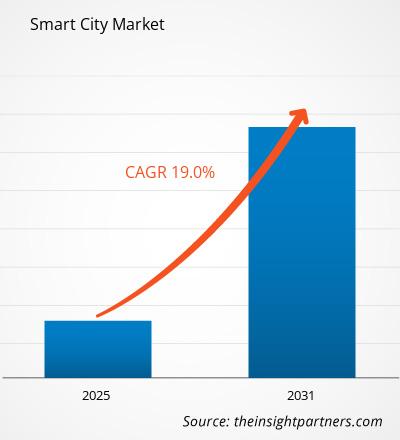Si prevede che il mercato delle città intelligenti crescerà da 1.094,23 miliardi di dollari nel 2022 a 3.110,58 miliardi di dollari entro il 2031; si stima che crescerà a un CAGR del 19,0% dal 2022 al 2031.
Le città intelligenti sono un concetto in cui vari aspetti di una città o di una provincia si basano su tecnologie avanzate. Queste città utilizzano la tecnologia digitale e Internet per migliorare le prestazioni dei servizi e la qualità della vita ottimizzando l'energia e migliorando la sicurezza per i cittadini. Il concetto di città intelligente mira a sviluppare una connettività e un'infrastruttura robuste per consentire l'accesso alle informazioni in tempo reale per la creazione di un sistema di gestione che colleghi in modo efficiente cittadini, fornitori di servizi e amministratori. Inoltre, il governo garantisce che gli abitanti partecipino attivamente al miglioramento della sostenibilità e della produttività complessive dei servizi fornendo alle città infrastrutture elementari.
La tecnologia delle infrastrutture intelligenti è cambiata in modo significativo nel tempo e varie discipline, come l'automazione degli edifici per la gestione delle strutture e delle risposte alle emergenze, l'ottimizzazione energetica degli edifici, la gestione dei parcheggi e i sistemi di comunicazione all'interno degli edifici, sono ora ampiamente adottate. Inoltre, le iniziative di green building hanno assunto un ruolo centrale in molti paesi, in particolare in Europa, Nord America e nelle regioni APAC. L'attenzione alla riduzione del consumo energetico e le preoccupazioni sulla proliferazione di rifiuti ambientali sono i principali fattori trainanti per lo sviluppo delle smart city. Si prevede che i trasporti saranno un'altra importante area di interesse durante il periodo di previsione del mercato delle smart city .
Personalizza questo report in base alle tue esigenze
Riceverai la personalizzazione gratuita di qualsiasi report, comprese parti di questo report, o analisi a livello nazionale, pacchetto dati Excel, oltre a usufruire di grandi offerte e sconti per start-up e università
- Scopri le principali tendenze di mercato in questo rapporto.Questo campione GRATUITO includerà analisi di dati che spaziano dalle tendenze di mercato alle stime e alle previsioni.
L'esaurimento delle fonti energetiche e la gestione inefficiente delle risorse stanno gradualmente diventando preoccupazioni importanti in tutto il mondo. Ciò sta guidando la domanda di soluzioni energetiche intelligenti in tutto il mondo. I sistemi di gestione energetica intelligenti utilizzano sensori, contatori avanzati, fonti di energia rinnovabile , controlli digitali e strumenti analitici per automatizzare, monitorare e ottimizzare la distribuzione e l'utilizzo dell'energia. Tali sistemi ottimizzano il funzionamento e l'utilizzo della rete bilanciando le esigenze delle diverse parti interessate coinvolte (consumatori, produttori e fornitori). Esistono diverse innovazioni nell'infrastruttura energetica intelligente, come la generazione distribuita di energia rinnovabile, le microreti, le tecnologie di rete intelligente, l'accumulo di energia, la risposta automatizzata alla domanda, le centrali elettriche virtuali e le innovazioni lato domanda come veicoli elettrici ed elettrodomestici intelligenti. Tali innovazioni forniscono una rete estesa di dispositivi energetici intelligenti in una città, con una visione dettagliata dei modelli di consumo energetico, consentendo programmi di monitoraggio energetico basati sulla comunità e migliorando l'efficienza energetica degli edifici.
Analisi regionale del mercato delle città intelligenti
Da una prospettiva regionale, il Nord America ha detenuto la quota maggiore del mercato globale delle smart city nel 2021. L'elevata adozione di soluzioni tecnologicamente avanzate in tutti i settori industriali della regione sta contribuendo alla crescita del mercato delle smart city nordamericane. Il crescente supporto governativo all'adozione della tecnologia attraverso l'annuncio di sussidi, crediti d'imposta e finanziamenti alle industrie per lo sviluppo tecnologico sta ulteriormente catalizzando il mercato, offrendo così opportunità commerciali redditizie agli attori del mercato delle smart city che operano nella regione. Ad esempio, a novembre 2021, il governo federale degli Stati Uniti ha annunciato un finanziamento di 500 milioni di dollari nell'ambito dell'Infrastructure Investment and Jobs Act per superare le sfide delle smart city. Inoltre, la presenza di diversi attori del mercato delle smart city nella regione, impegnati in innovazione costante e sviluppo di prodotti, sta ulteriormente guidando il mercato delle smart city nordamericane.
Approfondimenti di mercato – Mercato delle città intelligenti
Approfondimenti verticali basati sul settore
In base al settore verticale, la dimensione del mercato delle smart city è segmentata in infrastrutture intelligenti , energia intelligente, governance intelligente, trasporti intelligenti, assistenza sanitaria intelligente e istruzione intelligente. Si prevede che il segmento dei trasporti intelligenti crescerà al CAGR più elevato nel periodo di previsione. I trasporti intelligenti sono un'infrastruttura innovativa di traffico e mobilità basata su nuove tecnologie e progettata per risparmiare risorse per la massima efficienza. Si prevede che l'implementazione di tecnologie chiave come cloud computing , 4G, apprendimento automatico e operazioni in nuovi progetti diventerà più comunemente applicata a sistemi di trasporto intelligenti come le ferrovie, fornendo servizi efficienti per passeggeri e merci in tutto il mondo, con conseguente generazione di un pool di opportunità per numerosi attori del settore nell'ecosistema delle smart city. Ciò attirerebbe anche vari capitalisti e investitori, portando a una crescita enorme nel mercato dei trasporti intelligenti.
Approfondimenti regionali sul mercato delle città intelligenti
Le tendenze regionali e i fattori che influenzano il mercato delle città intelligenti durante il periodo di previsione sono stati ampiamente spiegati dagli analisti di Insight Partners. Questa sezione discute anche i segmenti e la geografia del mercato delle città intelligenti in Nord America, Europa, Asia Pacifico, Medio Oriente e Africa, e Sud e Centro America.

- Ottieni i dati specifici regionali per il mercato delle città intelligenti
Ambito del rapporto sul mercato delle città intelligenti
| Attributo del report | Dettagli |
|---|---|
| Dimensioni del mercato nel 2023 | 1,30 trilioni di dollari USA |
| Dimensioni del mercato entro il 2031 | 5,24 trilioni di dollari USA |
| CAGR globale (2023-2031) | 19,00% |
| Dati storici | 2021-2022 |
| Periodo di previsione | 2024-2031 |
| Segmenti coperti | Per settore verticale
|
| Regioni e Paesi coperti | America del Nord
|
| Leader di mercato e profili aziendali chiave |
|
Densità degli attori del mercato: comprendere il suo impatto sulle dinamiche aziendali
Il mercato Smart City Market sta crescendo rapidamente, spinto dalla crescente domanda degli utenti finali dovuta a fattori quali l'evoluzione delle preferenze dei consumatori, i progressi tecnologici e una maggiore consapevolezza dei vantaggi del prodotto. Con l'aumento della domanda, le aziende stanno ampliando le loro offerte, innovando per soddisfare le esigenze dei consumatori e capitalizzando sulle tendenze emergenti, il che alimenta ulteriormente la crescita del mercato.
La densità degli operatori di mercato si riferisce alla distribuzione di aziende o società che operano in un particolare mercato o settore. Indica quanti concorrenti (operatori di mercato) sono presenti in un dato spazio di mercato in relazione alle sue dimensioni o al valore di mercato totale.
Le principali aziende che operano nel mercato delle Smart City sono:
- ABB Ltd.
- Accentura
- Cisco
- Ericsson
- Schneider elettrico
- GE
Disclaimer : le aziende elencate sopra non sono classificate secondo un ordine particolare.

- Ottieni una panoramica dei principali attori del mercato delle città intelligenti
Gli operatori che operano nel mercato delle smart city si concentrano principalmente sullo sviluppo di prodotti avanzati ed efficienti.
- Nell'ottobre 2021, Siemens AG ha annunciato l'acquisizione di Squills. Questa acquisizione ha rafforzato le soluzioni di mobilità dell'azienda, come il software di prenotazione e biglietteria.
- Nel maggio 2021, Microsoft Corporation e Itron Inc hanno stretto una partnership strategica per offrire in modo collaborativo servizi di gestione dei dispositivi mobili (MDM) altamente avanzati ai propri clienti.
La dimensione del mercato delle smart city è segmentata in cinque regioni principali: Nord America, Europa, Asia Pacifico (APAC), Medio Oriente e Africa e Sud America. Nel 2022, il Nord America ha guidato il mercato con una quota di fatturato sostanziale, seguita dall'Europa. Inoltre, si prevede che l'Asia Pacifico registrerà il CAGR più elevato nel mercato delle smart city dal 2022 al 2031.
I principali attori del mercato globale delle smart city includono ABB Ltd; Cisco Systems, Inc.; Oracle Corporation; Microsoft Corporation; e IBM Corporation. Oltre a questi, durante lo studio di ricerca sono stati analizzati diversi altri attori, tra cui Accenture, General Electric Company, Schneider Electric SE, Siemens AG ed Ericsson AB.
- Analisi storica (2 anni), anno base, previsione (7 anni) con CAGR
- Analisi PEST e SWOT
- Valore/volume delle dimensioni del mercato - Globale, regionale, nazionale
- Industria e panorama competitivo
- Set di dati Excel


- HVAC Sensors Market
- Dealer Management System Market
- Social Employee Recognition System Market
- Electronic Signature Software Market
- Public Key Infrastructure Market
- Enzymatic DNA Synthesis Market
- Intraoperative Neuromonitoring Market
- Cut Flowers Market
- Health Economics and Outcome Research (HEOR) Services Market
- Data Annotation Tools Market

Report Coverage
Revenue forecast, Company Analysis, Industry landscape, Growth factors, and Trends

Segment Covered
This text is related
to segments covered.

Regional Scope
North America, Europe, Asia Pacific, Middle East & Africa, South & Central America

Country Scope
This text is related
to country scope.
Trends and growth analysis reports related to Electronics and Semiconductor : READ MORE..
The List of Companies - Smart Cities Market
- ABB Ltd.
- Accenture
- Cisco
- Ericsson
- Schneider Electric
- GE
- Microsoft
- IBM Corporation
- Oracle
- Siemens
The Insight Partners performs research in 4 major stages: Data Collection & Secondary Research, Primary Research, Data Analysis and Data Triangulation & Final Review.
- Data Collection and Secondary Research:
As a market research and consulting firm operating from a decade, we have published and advised several client across the globe. First step for any study will start with an assessment of currently available data and insights from existing reports. Further, historical and current market information is collected from Investor Presentations, Annual Reports, SEC Filings, etc., and other information related to company’s performance and market positioning are gathered from Paid Databases (Factiva, Hoovers, and Reuters) and various other publications available in public domain.
Several associations trade associates, technical forums, institutes, societies and organization are accessed to gain technical as well as market related insights through their publications such as research papers, blogs and press releases related to the studies are referred to get cues about the market. Further, white papers, journals, magazines, and other news articles published in last 3 years are scrutinized and analyzed to understand the current market trends.
- Primary Research:
The primarily interview analysis comprise of data obtained from industry participants interview and answers to survey questions gathered by in-house primary team.
For primary research, interviews are conducted with industry experts/CEOs/Marketing Managers/VPs/Subject Matter Experts from both demand and supply side to get a 360-degree view of the market. The primary team conducts several interviews based on the complexity of the markets to understand the various market trends and dynamics which makes research more credible and precise.
A typical research interview fulfils the following functions:
- Provides first-hand information on the market size, market trends, growth trends, competitive landscape, and outlook
- Validates and strengthens in-house secondary research findings
- Develops the analysis team’s expertise and market understanding
Primary research involves email interactions and telephone interviews for each market, category, segment, and sub-segment across geographies. The participants who typically take part in such a process include, but are not limited to:
- Industry participants: VPs, business development managers, market intelligence managers and national sales managers
- Outside experts: Valuation experts, research analysts and key opinion leaders specializing in the electronics and semiconductor industry.
Below is the breakup of our primary respondents by company, designation, and region:

Once we receive the confirmation from primary research sources or primary respondents, we finalize the base year market estimation and forecast the data as per the macroeconomic and microeconomic factors assessed during data collection.
- Data Analysis:
Once data is validated through both secondary as well as primary respondents, we finalize the market estimations by hypothesis formulation and factor analysis at regional and country level.
- Macro-Economic Factor Analysis:
We analyse macroeconomic indicators such the gross domestic product (GDP), increase in the demand for goods and services across industries, technological advancement, regional economic growth, governmental policies, the influence of COVID-19, PEST analysis, and other aspects. This analysis aids in setting benchmarks for various nations/regions and approximating market splits. Additionally, the general trend of the aforementioned components aid in determining the market's development possibilities.
- Country Level Data:
Various factors that are especially aligned to the country are taken into account to determine the market size for a certain area and country, including the presence of vendors, such as headquarters and offices, the country's GDP, demand patterns, and industry growth. To comprehend the market dynamics for the nation, a number of growth variables, inhibitors, application areas, and current market trends are researched. The aforementioned elements aid in determining the country's overall market's growth potential.
- Company Profile:
The “Table of Contents” is formulated by listing and analyzing more than 25 - 30 companies operating in the market ecosystem across geographies. However, we profile only 10 companies as a standard practice in our syndicate reports. These 10 companies comprise leading, emerging, and regional players. Nonetheless, our analysis is not restricted to the 10 listed companies, we also analyze other companies present in the market to develop a holistic view and understand the prevailing trends. The “Company Profiles” section in the report covers key facts, business description, products & services, financial information, SWOT analysis, and key developments. The financial information presented is extracted from the annual reports and official documents of the publicly listed companies. Upon collecting the information for the sections of respective companies, we verify them via various primary sources and then compile the data in respective company profiles. The company level information helps us in deriving the base number as well as in forecasting the market size.
- Developing Base Number:
Aggregation of sales statistics (2020-2022) and macro-economic factor, and other secondary and primary research insights are utilized to arrive at base number and related market shares for 2022. The data gaps are identified in this step and relevant market data is analyzed, collected from paid primary interviews or databases. On finalizing the base year market size, forecasts are developed on the basis of macro-economic, industry and market growth factors and company level analysis.
- Data Triangulation and Final Review:
The market findings and base year market size calculations are validated from supply as well as demand side. Demand side validations are based on macro-economic factor analysis and benchmarks for respective regions and countries. In case of supply side validations, revenues of major companies are estimated (in case not available) based on industry benchmark, approximate number of employees, product portfolio, and primary interviews revenues are gathered. Further revenue from target product/service segment is assessed to avoid overshooting of market statistics. In case of heavy deviations between supply and demand side values, all thes steps are repeated to achieve synchronization.
We follow an iterative model, wherein we share our research findings with Subject Matter Experts (SME’s) and Key Opinion Leaders (KOLs) until consensus view of the market is not formulated – this model negates any drastic deviation in the opinions of experts. Only validated and universally acceptable research findings are quoted in our reports.
We have important check points that we use to validate our research findings – which we call – data triangulation, where we validate the information, we generate from secondary sources with primary interviews and then we re-validate with our internal data bases and Subject matter experts. This comprehensive model enables us to deliver high quality, reliable data in shortest possible time.


 Ottieni un campione gratuito per questo repot
Ottieni un campione gratuito per questo repot